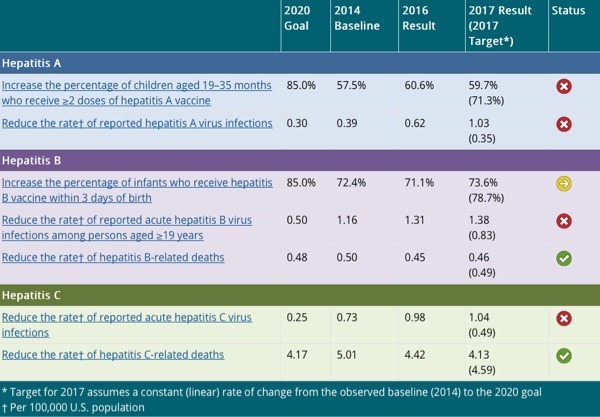National Viral Hepatitis Progress Report - 2019

The Centers for Disease Control and Prevention (CDC) strives to prevent viral hepatitis infections and eliminate disease and mortality caused by viral hepatitis. The National Viral Hepatitis Progress Report provides information on progress in the implementation of recommended interventions and the impact these interventions are having on prevention of viral hepatitis transmission, disease, and associated mortality.
The seven indicators and accompanying 2020 goals compiled specifically for the National Progress Report were adapted from other initiatives, including Healthy People 2020external icon, HHS’s National Viral Hepatitis Action Plan, 2017-2020 pdf icon[PDF – 84 pages]external icon, and CDC’s Viral Hepatitis Strategic Plan, 2016-2020 pdf icon[PDF – 17 pages].
- No progress was made over the past year in increasing hepatitis A vaccination coverage. The large increases in the hepatitis A incidence rate for 2016 and 2017 related to widespread person-to-person outbreaks highlights the importance of vaccination as well as public health surveillance to identify and respond to outbreaks of hepatitis A.
- Progress is not being made in reducing the incidence of acute hepatitis B among adults, and incidence increased slightly from 2016 to 2017. Furthermore, while there was a slight increase in newborn hepatitis B vaccination coverage from 2016 to 2017, it was not enoughto reach the annual target, and more than a quarter of newborns did not receive hepatitis B vaccination within 3 days of birth in 2017, leaving these young children unnecessarily vulnerable to hepatitis B virus infection.
- Of great concern are the ongoing and apparent large increases in the incidence of reported acute hepatitis C. The lack of a hepatitis C vaccine and increases in injection-drug use related to the nation’s opioid crisis have contributed to these increases in acute hepatitis C. Efforts to curb hepatitis C virus (HCV) transmission and identify all new (acute) and existing (chronic) infections must continue, especially since well-tolerated, short-course treatments are available that can cure almost all HCV-infected persons.
- The nation has made progress towards reducing deaths related to hepatitis B and hepatitis C, and the 2020 goals for both targets have already been met for both mortality indicators.
